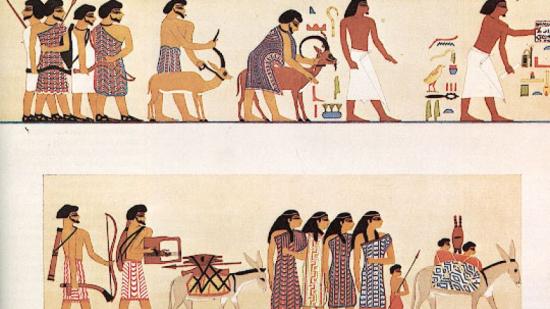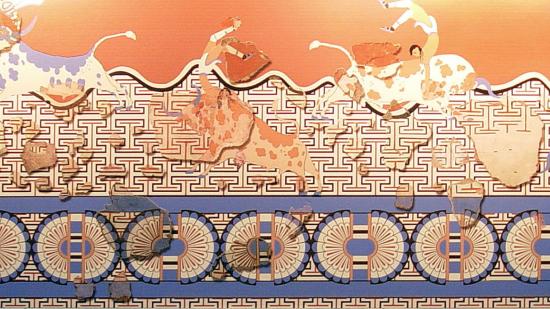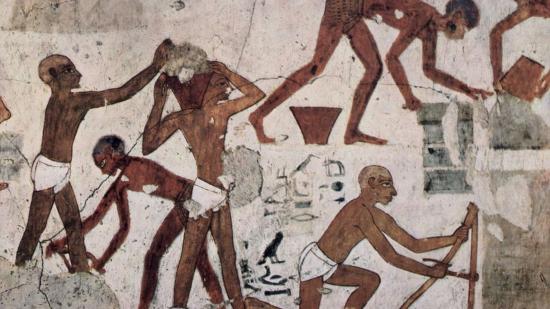Ancient Egypt had intimate relations with Canaan, and most of the Semitic peoples migrating there would have been Canaanite. But not all
Philippe Bohstrom
Source - http://www.haaretz.com/jewish/archaeology/.premium-1.713849
 The Ibscha Relief from the tomb of Khnumhotep II, showing Semitic traders (possibly the Hyksos) coming to Egypt some 4,000 years ago.NebMaatRa, Wikimedia Commons
The Ibscha Relief from the tomb of Khnumhotep II, showing Semitic traders (possibly the Hyksos) coming to Egypt some 4,000 years ago.NebMaatRa, Wikimedia Commons
Every Passover, Jews retell the story about the Hebrews' flight from slavery in Egypt and their miraculous escape across the Red Sea, giving birth to the nation of Israel. The colorful story has also been retold by Hollywood time and again, shaping the modern generation's understanding of the Israelite bondage in Egypt.
But if ancient Egypt had slaves from the region known today as Israel, were they really “Israelites”?
There is no direct evidence that people worshipping Yahweh sojourned in ancient Egypt, let alone during the time the Exodus is believed to have happened. There is indirect evidence that at least some did. What's for sure is that thousands of years ago, Egypt was crawling with Semitic-speaking peoples.
Canaanites ascendant
Throughout antiquity, Egypt was known as the breadbasket of the world. The annual flooding of the Nile produced rich harvests, and when famine hit neighboring lands, starving peoples often made their way to the fruitful soils of Egypt. The archaeological record clearly shows that at least some of these peoples were of Semitic origin, coming from Canaan specifically and the Levant in general.
In fact, the histories of both the Egyptian upper kingdom (ruled from Thebes in southern Egypt) and the lower kingdom (ruled from Avaris in the north), and Canaan were intimately tied together.
Starting over 4,000 years ago, Semites began crossing the deserts from Palestine into Egypt. The tomb of the high priest Khnumhotep II of the 20th century BCE even shows a scene of Semitic traders bringing offerings to the dead (top picture).
Some of these Semites came to Egypt as traders and immigrants. Others were prisoners of war, and yet others were sold into slavery by their own people. A papyrus mentions a wealthy Egyptian lord whose 77 slaves included 48 of Semitic origin.
In fact, by the late Middle Kingdom era, around 3700 years ago, Canaanites had actually achieved absolute power, in the form of a line of Canaanite pharaohs ruling the Lower Kingdom, coexisting with the Egyptian-ruled Upper Kingdom. (These Canaanite pharaohs included the mysterious "Yaqub," whose existence is attested by 27 scarabs found in Egypt, Canaan and Nubia and a famous one found at Shikmona, by Haifa.) The biblical tradition of the patriarch Jacob settling in Egypt could well derive from this time.
 Timeline, ancient Egypt, from 1900 BCE to 1100 BCE, roughly.Oscar Forss
Timeline, ancient Egypt, from 1900 BCE to 1100 BCE, roughly.Oscar Forss
The coming of the Hyksos
In time, the Canaanite leaders were themselves ousted by the Hyksos, a mysterious group who settled in Egypt some time before 1650 BCE, and who came to rule the Lower Kingdom from the city of Avaris. Controversy remains, but it is increasingly agreed that the Hyksos originated from northern Levant - Lebanon or Syria.
Some scholars believe the Semitic traders shown in the mural on Khnumhotep II's tomb are actually Hyksos.
Under the Hyksos' wing, the Canaanite population in the delta grew and waxed stronger, as shown by findings in ancient Avaris (Tell el-Dab'a). The Canaanite presence is attested by pottery that was Canaanite in form and chemically derived from Palestine. The dominant religious anti-Semitic burial practices in Avaris at the time were also Canaanite.
 Reconstructed Minoan wall fresco from Tell El-Dab'a, the archaeological site identified with the Hyksos capital of Avaris. Wikimedia Commons
Reconstructed Minoan wall fresco from Tell El-Dab'a, the archaeological site identified with the Hyksos capital of Avaris. Wikimedia Commons
Eventually, the Hyksos in their turn would be vanquished. After a 30-year blood feud, the kings of Thebe, led by Ahmose I (1539 BCE–1514 BCE) prevailed, capturing Avaris and uniting the Lower and Upper kingdoms into a single polity, the "New Kingdom". The Hyksos were driven out of Egypt through the Sinai into southern Canaan.
The Roman-era Jewish historian Josephus for one identifies the Hyksos with the Israelites. He cites the 3rd-century Egyptian scribe and priest Manetho, who wrote that after their expulsion, the Hyksos wandered in the desert before establishing Jerusalem.
Some scholars suspect that Exodus is based on distant Semitic memories of the expulsion of the Hyksos. Others are dubious about Manethos' history, which was penned centuries after the actual event.
Also, the Hyksos were expelled monarchs of Egypt, not slaves. Ultimately, they are not a very likely source for the Haggadah story. Yet another school thinks the Exodus happened hundreds of years later, during the time of the New Kingdom – and some suspect there were multiple expulsions and events that merged, over the millennia, into the Passover story.
 Ancient Egyptian wall art showing Ahmose defeating the Hyksos.Wikimedia Commons
Ancient Egyptian wall art showing Ahmose defeating the Hyksos.Wikimedia Commons
Enslaved by war
Ahmose not only expelled the Hyksos. He united ancient Egypt and began the process of expanding its empire to stretch over Canaan and Syria too.
Egyptian scribes of Ahmose I and Thutmoses III wrote boastfully of campaigns in the Levant, resulting in captured prisoners being enslaved in Egypt. Various descriptions perfectly match scenes in the Passover Haggadah.
The setting described in Exodus could be Egypt's East Delta, where the Nile floods every year. The area has no source of stone, and mud-brick structures repeatedly "melted" back into the mud and silt. Even stone temples have hardly survived here. Physical evidence of slaves working there isn't likely to have survived. But a leather scroll dating to the time of Ramesses II (1303 BCE-1213 BCE) describes a close account of brick-making apparently by enslaved prisoners of the wars in Canaan and Syria, which sounds very much like the biblical account. The scroll describes 40 taskmasters, each with a daily target of 2,000 bricks (see Exodus 5:6).
Other Egyptian papyruses (Anastasi III & IV) discuss using straws in mud bricks, as mentioned in Exodus 5:7: "You must not gather straw to give to the people to make bricks as formerly. Let themsleves go and gather straw for themselves".
 The tomb of vizier Rekhimire, ca. 1450 BCE, shows foreign slaves “making bricks for the workshop-storeplace of the Temple of Amun at Karnak in Thebes” and for a building ramp. Wikimedia Commons
The tomb of vizier Rekhimire, ca. 1450 BCE, shows foreign slaves “making bricks for the workshop-storeplace of the Temple of Amun at Karnak in Thebes” and for a building ramp. Wikimedia Commons
The tomb of vizier Rekhmire, ca. 1450 BCE, famously shows foreign slaves “making bricks for the workshop-storeplace of the Temple of Amun at Karnak in Thebes” and for a building ramp. They are labeled "captures brought-off by His Majesty for work at the Temple of Amun". Semites and Nubians are shown fetching and mixing mud and water, striking out bricks from molds, leaving them to dry and measuring their amount, under the watchful eyes of Egyptian overseers, each with a rod. The images bear out descriptions in Ex. 1:11-14; 5:1-21. (“They made their life bitter with hard labor, as they worked with clay mortar and bricks and in very form of slavery in the field” - Exodus 1:14a)
Also, the biblical description of how Hebrew slaves suffered under the lash is borne out by the Egyptian papyrus Bologna 1094, telling how two workers fled their taskmaster “because he beat them”. So it seems the biblical descriptions of Egyptian slavery are accurate.
Part.2